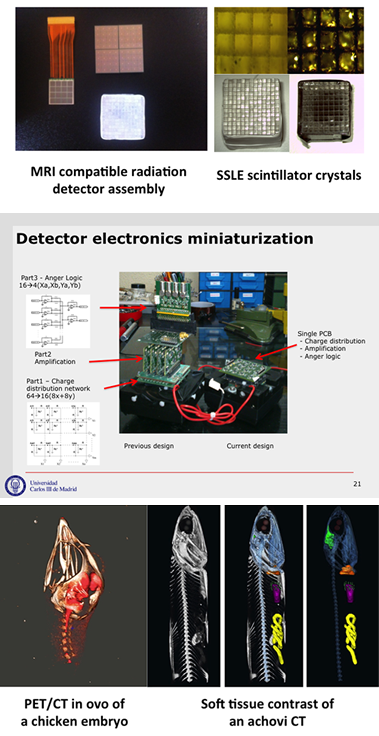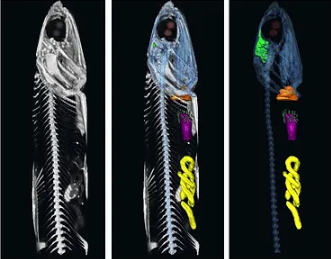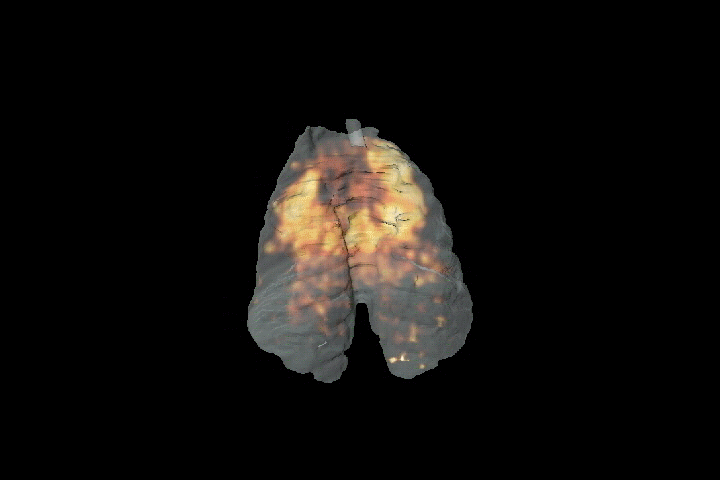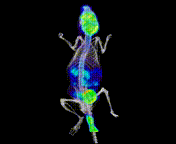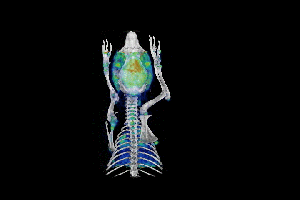
Research
PET technologies
This research area is mainly focused on the development of new biomedical molecular imaging technologies based on positron emission tomography, and in its applications in clinical and preclinical research. The use of translational designs is in the centre of our activity, aiming to introduce innovative essays of new biomedical paradigms based on in vivo functional imaging.
One of our main activities has been our contribution to the development of the ARGUS small-animal PET-CT scanner, which first commercial version was manufactured by Suinsa (now Sedecal) and licensed to General Electric Healthcare, who distributed it under the name eXplore Vista. That family of imagers integrates several technologies developed in our group (see ‘patents’ section) that enabled uncompromised high-sensitivity and high-resolution preclinical imaging. The ARGUS system has been one of the better sold preclinical PET scanners between 2005 and 2011. Newer multimodal versions integrate an x-ray CT scanner in tandem, and prototypes of MRI compatible detectors are under test.
We are currently developing a new generation of MRI-compatible radiation detectors that incorporate high performance capabilities to enable dynamic, real time advanced multimodal brain imaging. By integrating the latest semiconductor detector technologies (SiPM) and the more advanced signal processing methods (DoI, ToF, ToT, etc.) these new detectors provide uncompromised data in terms of sensitivity, spatial and temporal resolution. We base our current investigation on preceding successful research: previously developed MRI-compatible PET detectors are being upgraded to support “compressed sensing” encoding to increment the sustained data rate, and communication protocols based on optical technologies immune to EMI/RF noise.
Neuroscience and Imaging
PET/CT image of a chicken embryo inside the egg: CT quantification is used to determine its developmental stage, while Positron Emission Tomography shows the metabolism activity in the central nervous system.
Funded by the HFSP, Human Frontier Science Program grant RGP0004/2013.
Embryo brains make a developmental transition from a loose network of spontaneously-active cell groups to an organ that functions in a large-scale, highly-integrated and coordinated fashion. When in development do brains first start functioning in a “brain-like” fashion? The molecular, cellular and circuit mechanisms underlying this transition remain unknown. What mechanisms mediate the first onset of integrated, systems-like activity in the brain?
Using a combination of in-vivo molecular brain imaging, EEG and brain temperature recording with the classic chick embryo experimental system we hope reliably describe and phenotype the brain states of embryos in a precise way.
Making use this information in experimental paradigms will further advance scientific understanding of the developmental origins of sleep, waking, brain rhythms and other integrated aspects of systems function in higher vertebrate animals.
Curr Biol. 2012 May 22;22(10):852-61. doi: 10.1016/j.cub.2012.03.030
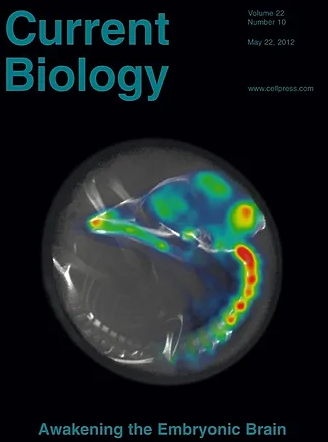
Monitoring Disease Progression
In-vivo PET/CT imaging for treatment monitoring: The hot color distribution represents an active inflammation in the lungs (gray) of a guinea pig. Quantification of the affected volume is used a surrogate of disease progression.
PET/CT images of a mouse lungs after intranasal administration of an aerosol containing FDG. Intranasal administration is one of the main routes of allergen challenge in mouse models of airway disease. Although it is widely used, it is not well established the amount of allergen that reaches the lung or is lost to the gastrointestinal tract. The local distribution and the dynamics of the challenge solution within the airways were visualized using dynamic PET imaging co-registered with CT. Mol Imaging Biol. 2009 Jul-Aug;11(4):263-8. doi: 10.1007/s11307-009-0199-y
Fig. 1 – CT images of a fish model are used to quantify size and density of different organs and masses under study. Scans are taken in a few minutes, and low dose protocols are used to minimize the radiation exposure of the sample.
Unpublished data.
Fig. 2 – Surface render of a mice lung study; low-dose CT imaging is used for the quantification of tissue densities in longitudinal protocols. Right: FDG image of a pulmonary infection reveals the increased metabolism of the affected tissue. These techniques are being used in oncology, COPD and infectious diseases.
Unpublished data.
Applications in cardiology
Fig. 3 – NH3 myocardium perfusion image of a control animal (left) compared to a sick one.
Mol Imaging Biol. 2012 Oct;14(5):541-5. doi: 10.1007/s11307-011-0538-
Small Animal Imaging
3D render of an in-vivo bird head PET/CT scan: bone structures surround the iso-surface of the FDG PET activity distribution (red).
Funded by the RIC-RETIC network, MINECO, Spanish Government.
Myocardial uptake of 18F-FDG may hamper visualization of lung lesions caused in mice models. Two approaches have been proposed for reducing myocardial uptake in these preclinical studies, namely, calcium channel blockers (verapamil) and high-fat diets such as commercial ketogenic diets and sunflower seed diets. The objective of this study was to compare the efficacy of these approaches in reducing myocardial uptake of 18F-FDG in mice. These images represent four different levels of myocardium uptake for the different treatments evaluated in this study.
PLoS ONE 9(9): e107999. doi:10.1371/journal.pone.0107999
Applications in oncology
PET/CT images of mice and rat xenotransplant and transgenic models. CT images are used for the precise location and segmentation of the tumor volumes, while tumor activity is obtained from the PET images.
Preclinical Molecular Imaging Technology
High-resolution, high-performance detectors that integrate the latest technologies enable in vivo studies with excellent image quality and accurate quantification of the physiological parameters being studied.
Our goal was to develop a new generation of MRI-compatible radiation detectors that incorporate high performance capabilities to enable dynamic, real time advanced multimodal brain imaging. By integrating the latest semiconductor detector technologies (SiPM) and the more advanced signal processing methods (DoI, ToF, ToT, etc.) these new detectors provide uncompromised data in terms of sensitivity, spatial and temporal resolution. We base our current investigation on preceding successful research: previously developed MRI-compatible PET detectors are being upgraded to support “compressed sensing” encoding to increment the sustained data rate, and communication protocols based on optical technologies immune to EMI/RF noise.
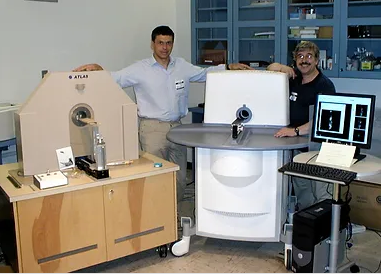
Original NIH ATLAS small-animal PET scanner and the ARGUS, first commercial version manufactured by Suinsa, licensed to General Electric Healthcare, and distributed under the name eXplore Vista.These imagers integrate several technologies (see ‘patents’ section) that enable an uncompromised high sensitivity and high resolution images. This system has been one of the better sold preclinical PET scanners between 2005 and 2011. Newer versions integrate an x-ray CT scanner in tandem, and prototypes coupled to MRI systems are under test.
Developmens partially founded by

The International Human Frontier Science Program Organization (HFSPO)
Innovative Medicines Initiative (IMI) Joint Undertaking, EU-FP7
Comunidad de Madrid
European ITN project FP7-PEOPLE-2012-ITN, PITN-GA-2012-317446-INFIERI

